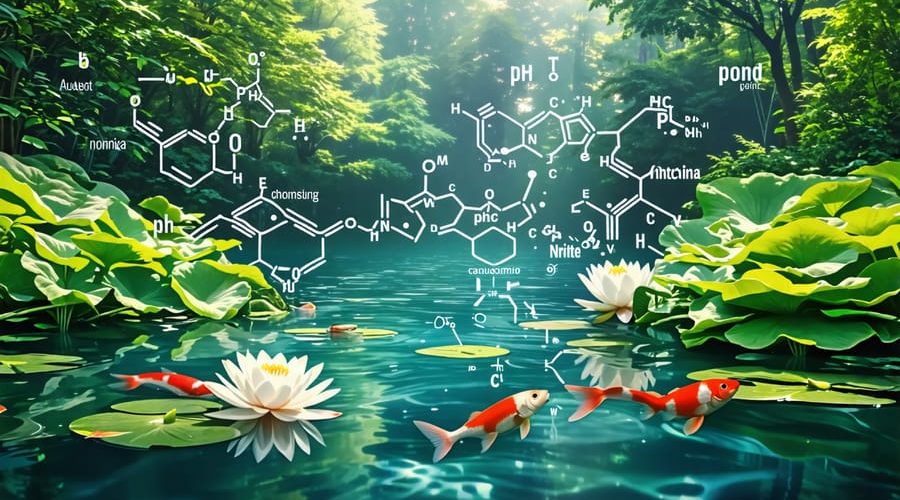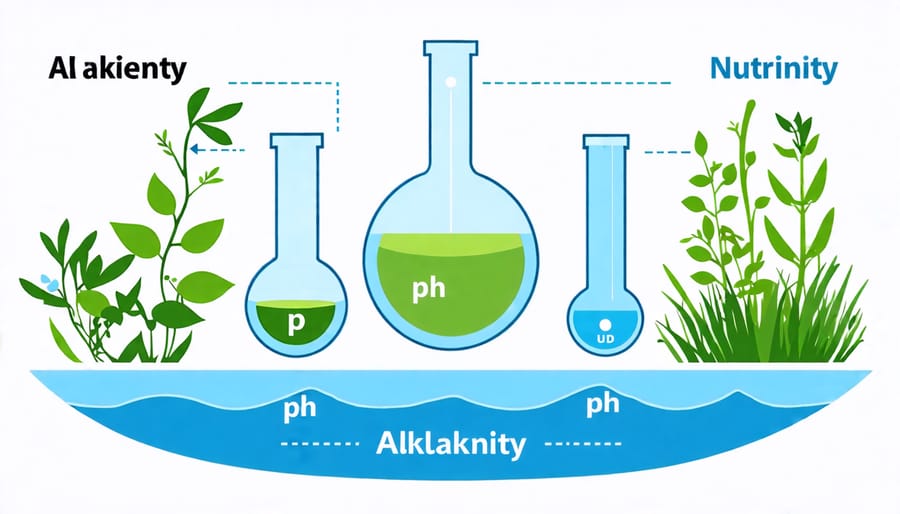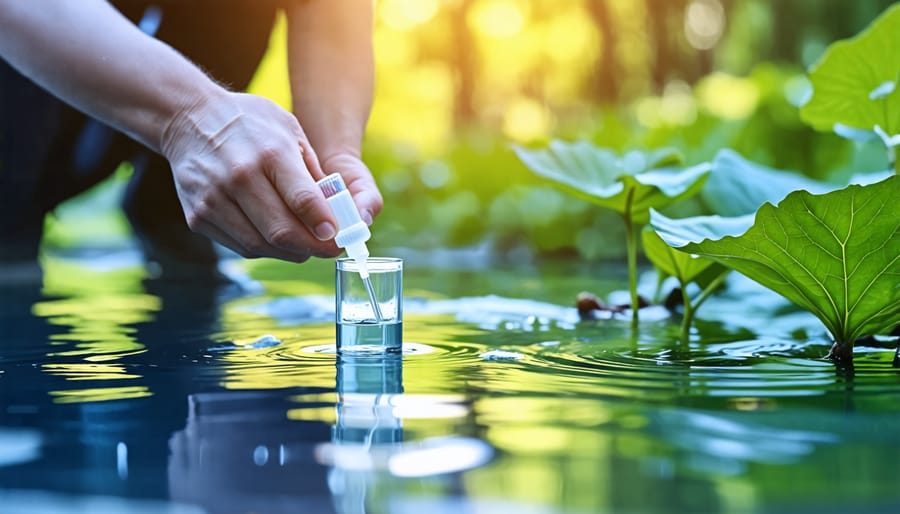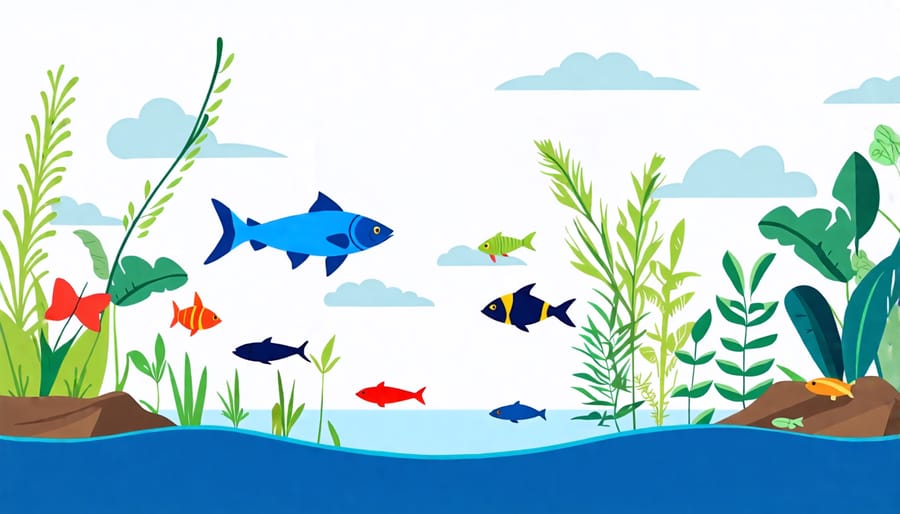
Unlock Crystal-Clear Waters: Master the Chemistry of Your Pond
Test water quality regularly to ensure a healthy balance of pH, ammonia, nitrite, and nitrate levels. Create aeration by installing a water pump or fountain to promote oxygenation, benefiting fish and plant life. Use beneficial bacteria to break down waste and reduce algae blooms. Regularly remove debris and fallen leaves to prevent excess nutrient accumulation and obstruction. To always keep your pond clear, consider planting floating plants like water lilies to provide natural shade and balance. By implementing these measures, you can maintain a thriving and crystal-clear pond ecosystem.
What Is Pond Chemistry?
Understanding pond chemistry is crucial for maintaining a healthy aquatic environment. At the heart of pond chemistry are elements like pH, alkalinity, and nutrients, each playing a vital role in your pond’s overall health.
Starting with pH, this measures how acidic or alkaline your pond water is on a scale from 0 to 14. A balance is needed, usually between 6.5 and 8.5, since extreme pH levels can stress or harm aquatic life. Regularly testing and adjusting the pH can be a part of your pond care routine, much like ensuring your home aquarium is just right.
Next is alkalinity, which acts as a buffer by keeping your pond’s pH stable. Alkalinity is the measure of carbonate and bicarbonate ions, and having a proper balance means fewer drastic pH shifts. Think of it as the gentle hand keeping everything steady, especially after a rainstorm when water chemistry can change rapidly.
Nutrients like nitrogen and phosphorus are also crucial, but they can be tricky. While they support plant growth, an excess can lead to more algae than you’d like, turning your oasis into a murky green mess. Managing these nutrients might require occasional water treatments or introducing plants that naturally help absorb them.
Each of these elements intertwines, like a web, affecting the clarity, odor, and life within your pond. Keeping a keen eye on them ensures your pond remains a thriving, beautiful feature of your outdoor space, offering a serene escape in your backyard. Remember, a little regular attention goes a long way, ensuring a lush and lively pond teeming with life.

Essential Components of Pond Chemistry
Understanding pH Levels
The pH level of your pond is like the heartbeat of the water, significantly impacting the well-being of your aquatic life. Ideally, a pond’s pH should be between 6.5 and 8.5 to ensure a harmonious environment where fish, plants, and beneficial bacteria thrive. If the pH slips outside this range, fish may become stressed, plants might struggle, and unwanted algae could take over. It’s important to regularly monitor these levels; you can easily do this with a basic pH test kit available at garden centers. Once you’ve got the readings, what’s next? If you find your water too acidic or alkaline, don’t worry. A few DIY fixes can help. For instance, adding crushed limestone or baking soda can elevate low pH, while peat moss can help lower it. It’s kind of like adjusting a recipe to get the perfect taste balance! And remember, good filtration, like using external filters, helps maintain stable pH levels. Personal tip: I’ve seen my koi rejoice with a stable pH. Happy pond keeping!
Alkalinity and Hardness
Understanding alkalinity and hardness is key to maintaining a healthy pond ecosystem. Alkalinity acts as a buffer for your pond’s pH, meaning it helps stabilize the water’s acidity levels. This stability is crucial for the well-being of aquatic life, as sudden pH changes can be harmful to fish and plants. You can think of alkalinity as the pond’s security blanket, keeping things balanced.
On the other hand, hardness refers to the concentration of calcium and magnesium in the water. These minerals are vital for the health of your pond’s inhabitants. Fish need calcium for proper bone and scale development, while plants rely on both minerals for robust growth and photosynthesis.
For DIY pond-lovers, maintaining the right levels of alkalinity and hardness doesn’t have to be complicated. Regularly testing your pond water with easy-to-use kits can help you ensure these elements are within the ideal range, supporting a thriving aquatic environment that’s both beautiful and sustainable.
Nutrient Balance
Pond chemistry can be a delicate balancing act, much like a seesaw. At the heart of this balancing act is managing nutrients like nitrogen and phosphorus, which play a crucial role in the health of your pond. When these nutrients accumulate, they can lead to algal blooms, turning your picturesque pond into a green, murky mess. Let me share a little insight from my own experience—finding that perfect balance can transform your pond from ordinary to extraordinary.
Nitrogen and phosphorus are essential for plant growth, but too much of a good thing can cause issues. Algae absolutely love these nutrients and will grow exponentially when they’re in abundance. This could result in what’s often called an “algae bloom.” Not only do these blooms spoil your pond’s appearance, but they can also lower the oxygen levels in the water, affecting the fish and other aquatic life thriving there.
To keep your pond water sparkling and healthy, focus on maintaining a natural nutrient balance. Regularly clear out debris and manage plant life, keeping in mind that every step you take impacts this delicate ecosystem. By being proactive, you can help prevent unwanted algae and maintain a pond that’s vibrant and full of life. It’s all about finding harmony so your pond remains a tranquil retreat right in your backyard.
Testing and Monitoring Your Pond Chemistry
Testing and monitoring your pond chemistry is essential for maintaining a healthy aquatic environment. For DIY enthusiasts and pond caretakers alike, having the right tools and knowledge at your fingertips can make this process enjoyable and rewarding. Let’s dive in!
Start by investing in a reliable pond test kit. These are designed to measure key parameters like pH, ammonia, nitrite, and nitrate levels. Most kits come with easy-to-read charts and color-coded results, so you can quickly assess your pond’s water quality. You don’t need to be a chemist to use them; just follow the instructions provided, and you’ll gain invaluable insights into your pond’s chemistry.
Establish a regular testing schedule. Consistency is key—aim to test your water every week or two, depending on the size of your pond and its inhabitants. This routine enables you to spot changes early and take necessary action before minor issues become major problems. If you’re a beginner, setting a reminder on your phone can help make this a seamless part of your pond care routine.
Keep a pond journal to track your results. This might sound a bit old-school, but jotting down your findings helps you observe trends and patterns over time. You’ll develop a clearer picture of how different factors, like seasons and weather, affect your pond. Plus, it’s rewarding to look back and see your pond’s progress!
Don’t hesitate to share your experiences with fellow pond enthusiasts. Online forums and local garden clubs can be treasure troves of advice and support. You might even pick up a handy tip or two while sharing your own insights.
Remember, monitoring pond chemistry isn’t just about solving problems—it’s about celebrating the thriving ecosystem you’re nurturing. So grab your test kit, unleash your inner scientist, and enjoy the journey of pond keeping!

Practical Tips for Maintaining Healthy Pond Chemistry
Maintaining healthy pond chemistry is key to creating a thriving aquatic environment. Start by regularly testing your pond water for pH, ammonia, nitrite, and nitrate levels. Each parameter tells a story; for example, I once noticed our koi were less active, and a quick test revealed high ammonia levels due to overfeeding, which we promptly corrected.
First, aim to keep the pH between 6.5 and 8.5 as it supports most aquatic plants and fish. Use a pH meter or test kit weekly and adjust gradually with products designed for ponds if needed. Extreme pH shifts can stress your fish, so take it slow.
Managing algae is another aspect of maintaining pond chemistry. Balance sunlight and nutrients by introducing floating plants like water lilies, which I’ve found not only add beauty but also reduce algae growth by providing shade.
Regular water changes play a vital role too. Try to replace 10-20% of the pond water monthly to dilute impurities. During one particularly dry summer, topping up my pond with rainwater collected from gutters made all the difference in reducing chloramines without added chemicals.
Additionally, ensure proper filtration. A quality biological filter helps maintain beneficial bacteria, breaking down toxic ammonia into safer nitrates. Cleaning your filter material without tap water retains these helpful bacteria.
Finally, seasonal maintenance matters. During autumn, cover your pond with a net to catch falling leaves, which can decompose and release harmful substances. Following these tips helps keep your pond’s chemistry balanced and your aquatic life happy year-round.
The Impact of Pond Chemistry on Aquatic Life
Imagine your pond as a delicate soup of life, where fish and plants rely on perfect chemistry for their well-being. Maintaining this balance is like being the chef in your own pond ecosystem. Essential elements such as pH, ammonia, nitrites, and nitrates play crucial roles here. A balanced pH level, for instance, ensures that both plant and fish life thrive, while too much ammonia or nitrites can be harmful. It’s like seasoning—too little, and life struggles; too much, and you’re inviting disaster.
For those of you with an aquaponics system, you’ve experienced firsthand the joy of seeing fish and plants symbiotically flourish, thanks to a well-maintained chemical balance. Regular testing of water chemistry is your key tool for success, ensuring that each component is within optimal ranges. This hands-on care not only prevents algae bloom and fish stress but also means your pond will look its vibrant best, rewarding you with a lively, thriving ecosystem. Every drop and measure counts, bringing you closer to a harmonious aquatic haven where all its inhabitants can prosper.

Conclusion
Embracing the world of pond care can transform your outdoor space into a thriving ecosystem. By understanding the chemistry and environment, you’re equipped to maintain balance and beauty in your pond. Whether you’re adjusting pH levels or ensuring adequate aeration, each step is vital in promoting a healthy habitat for aquatic life. Dive into this endeavor with enthusiasm and curiosity, knowing that every adjustment can lead to a more vibrant, serene setting. With these insights, you’re not just enhancing your pond—you’re shaping a living masterpiece that reflects your personal touch in harmony with nature.
